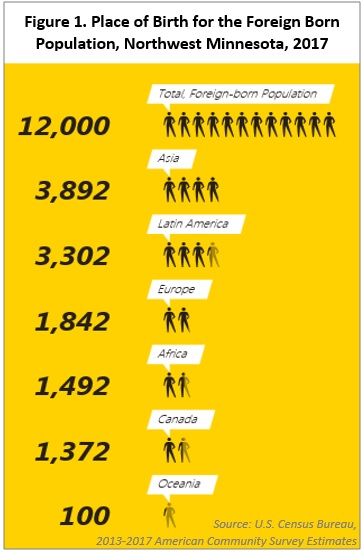 The presence of such industry powerhouses as Polaris, Arctic Cat and New Flyer make Northwest Minnesota a hub of transportation equipment manufacturing.
The presence of such industry powerhouses as Polaris, Arctic Cat and New Flyer make Northwest Minnesota a hub of transportation equipment manufacturing.
From wheat and potatoes to soybeans and sugar beets, the region is a major producer and processor of food staples and specialty agricultural products.
Want the freshest data delivered by email? Subscribe to our regional newsletters.
3/7/2019 4:30:00 PM
Cameron Macht
In the face of increasingly tight labor markets, a growing scarcity of workers is one of Minnesota’s most significant barriers to sustained economic growth. Because of these constraints, it has become evident that immigration will continue to be a vital source of the workforce that employers need to succeed. Though still a relatively small portion of Northwest Minnesota’s population, immigrants have become critical to the region’s economy, providing a rapid stream of new workers in the face of an aging native-born workforce.
According to the U.S. Census Bureau’s American Community Survey, Northwest Minnesota is now home to 12,000 foreign born residents, or about 2.1 percent of the total population. The number of immigrants in the region increased by 13.3 percent from 2010 to 2017, though that did not keep pace with the statewide growth rate of 22.2 percent (Figure 1).

DEED’s Regional Analysis & Outreach Unit put together a regional report detailing the characteristics of the foreign-born population in Northwest Minnesota. For example, the largest number of foreign born residents in the region were from Asia, accounting for one in every three immigrants. Most of these immigrants came from either Southeastern Asia, including the Philippines, Vietnam, and Laos; or Eastern Asia, primarily China and Korea.
Almost 30 percent of the region’s immigrants were from Latin America, including about 2,000 residents who were from Mexico. The fastest growth was coming from South America, most notably Brazil and Colombia.
Another 1,850 foreign-born residents were from Europe, though that was a 9 percent decline since 2010. In contrast, Northwest Minnesota saw a significant gain in the number of immigrants from Africa from 2010 to 2017. Nearly two-thirds of those new residents are from Eastern Africa, a population that doubled since 2010.
Close proximity to the Canada border meant the region welcomed about 1,400 immigrants from the north, giving Northwest the largest Canadian population in Greater Minnesota. The smallest number of immigrants in the region was from Oceania, which includes Australia and New Zealand.
Immigrants have a much younger age profile than the native-born population. In 2017, 52.3 percent of the foreign-born population were in their prime working years between 25 and 54 years of age, compared to just 34.3 percent of the total population. Likewise, just 12.4 percent of the region’s foreign-born population was 65 years and over, compared to 19.2 percent of the total population. However, only 8.3 percent of Northwest Minnesota’s immigrants were under 15 years of age, compared to 19.2 percent of the total population (Figure 2).

This younger age concentration is important to the region’s workforce. Statewide, 72.2 percent of the foreign-born population aged 16 years and over was actively participating in the labor force, which was actually higher than the native born population (69.6 percent). In Northwest Minnesota, that would equal about 7,650 available immigrant workers, comprising about 2.7 percent of the region’s workforce. While the region’s overall labor force growth was slowing, the number of immigrant workers in the region would have increased by about 960 workers from 2010 to 2017 – accounting for almost 25 percent of the region’s labor force growth this decade.
Contact Cameron Macht at or 320-441-6596.